COMMENT OF THE DAY: A BIG BLOW TO BAYOU BIKING  “. . . Have been riding Ant Hills since 1994. People who do not frequent this stretch of bayou may not know its beauty or usefulness but will be an irreplaceable loss of being able to enjoy the outdoors in Houston if allowed to go forward.” [Turning_Basin, commenting on New Overflow Pools Coming To Clear Out Trees, Anthills from the South Side of Buffalo Bayou] Photo of Terry Hershey Park: Save Buffalo Bayou
“. . . Have been riding Ant Hills since 1994. People who do not frequent this stretch of bayou may not know its beauty or usefulness but will be an irreplaceable loss of being able to enjoy the outdoors in Houston if allowed to go forward.” [Turning_Basin, commenting on New Overflow Pools Coming To Clear Out Trees, Anthills from the South Side of Buffalo Bayou] Photo of Terry Hershey Park: Save Buffalo Bayou
Tag: Bayous and Waterways
NEW BIRD-SHAPED BOATS PUT FORMER WOODLANDS CRUISER PASSENGERS IN THE DRIVER’S SEAT  A flock of 10 swan-shaped boats has now picked up where The Woodlands’ 6 Waterway Cruisers left off when they were destroyed by Harvey last year — reports the Villager’s Marialuisa Rincon — rendering the township’s shipping channels unnavigable by public transit. (One Cruiser survived, but town officials decommissioned it anyway when they terminated their contract with the boat service’s operator in February.) Now, their “long-necked replacements” have former passengers taking water travel into their own hands through the use of a rudder — and their feet, by pedaling — to get where they want to go. Lake Robbins and anything past the Anadarko Bridge along the north edge of Lake Woodlands are off-limits — but aside from that, it’s pretty much free swim in the rest of the lake, as well as the upper and lower waterways. After hours, all bird boats rest in the Riva Row Boat House opposite The Pavilion. [Houston Chronicle; more info] Photo: The Woodlands Township
A flock of 10 swan-shaped boats has now picked up where The Woodlands’ 6 Waterway Cruisers left off when they were destroyed by Harvey last year — reports the Villager’s Marialuisa Rincon — rendering the township’s shipping channels unnavigable by public transit. (One Cruiser survived, but town officials decommissioned it anyway when they terminated their contract with the boat service’s operator in February.) Now, their “long-necked replacements” have former passengers taking water travel into their own hands through the use of a rudder — and their feet, by pedaling — to get where they want to go. Lake Robbins and anything past the Anadarko Bridge along the north edge of Lake Woodlands are off-limits — but aside from that, it’s pretty much free swim in the rest of the lake, as well as the upper and lower waterways. After hours, all bird boats rest in the Riva Row Boat House opposite The Pavilion. [Houston Chronicle; more info] Photo: The Woodlands Township
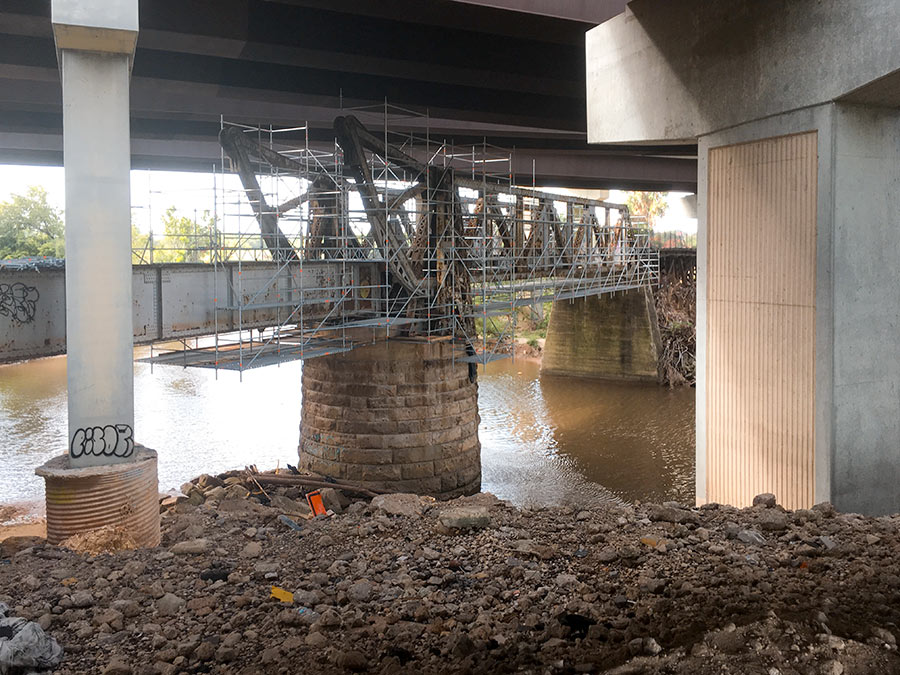
Here’s one of Houston’s latest walkable undertakings: converting the former railroad bridge beneath 59 to a pedestrian bridge that’ll link the trail along the bayou’s north bank to planned pedestrian segments south of waterway. It’s now overshadowed by the tangle of overpasses directly above it, but might not be once TxDOT starts straightening out 59 by nudging it east (and pairing it with a parallel segment of I-45) as part of its grand plan for north Houston highway improvement.
No southern trail segments are in place yet to greet the bridge upon its landfall just east of Downtown, but they will be soon: TxDOT’s already broken ground on a trail that’ll skirt the bayou as it crosses through the Houston Housing Authority’s Clayton Homes Neighborhood east of 59.
It’ll link up with the southern trail segment that does exist and runs east toward Lockwood Dr., as indicated by the gray line in the map below:
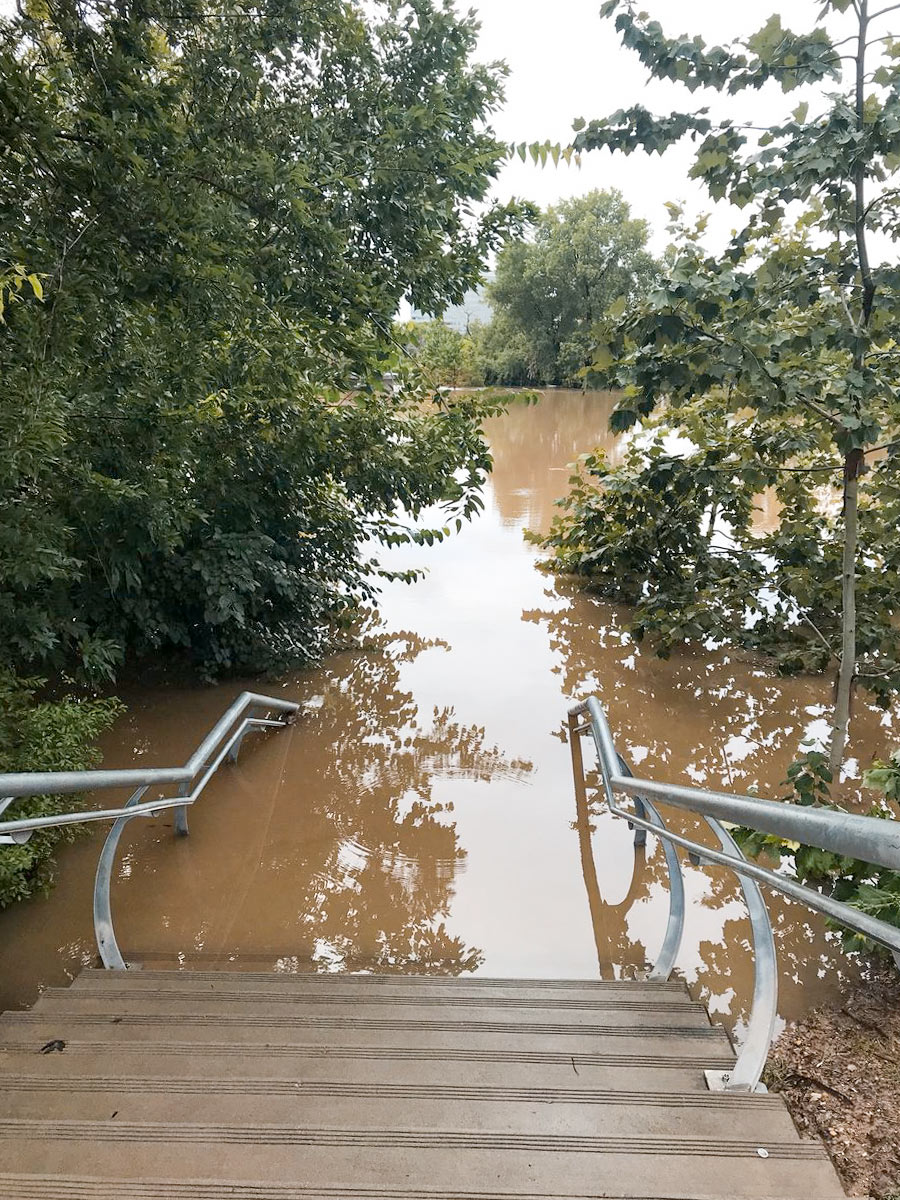
On-the-ground footage from KHOU reporter David Gonzalez shows just how much water the Johnny Steele Dog Park — redone and reopened 3 weeks ago following its last flood — took on yesterday. By the end of the downpour, floodwaters had risen up a few steps from where the park begins at the foot of the staircase leading to Allen Pkwy., as shown in the photo above.
That left these 2 out of luck:
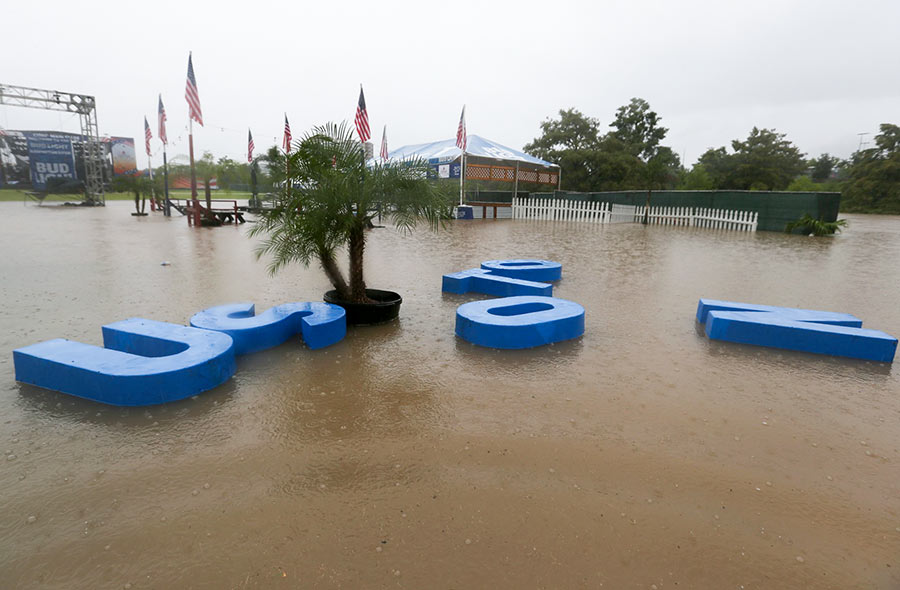
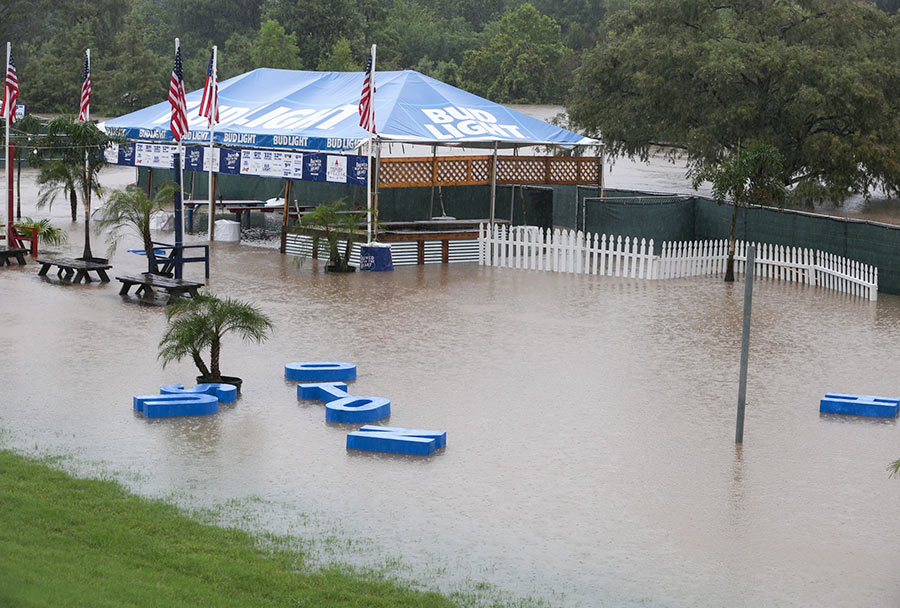
Mayor Turner had already cancelled all Freedom Over Texas events yesterday — save for the fireworks — by the time the HOUSTON sign planted in Eleanor Tinsley Park got caught up in the flow of things and began drifting downstream, away from the Bud Light Beer Garden that it originally fronted. Despite the disorder, the letters managed to stay afloat during their time on the water, captured by Chronicle photographer Yi-Chin Lee.
They ended up making landfall in the middle of the lawn:
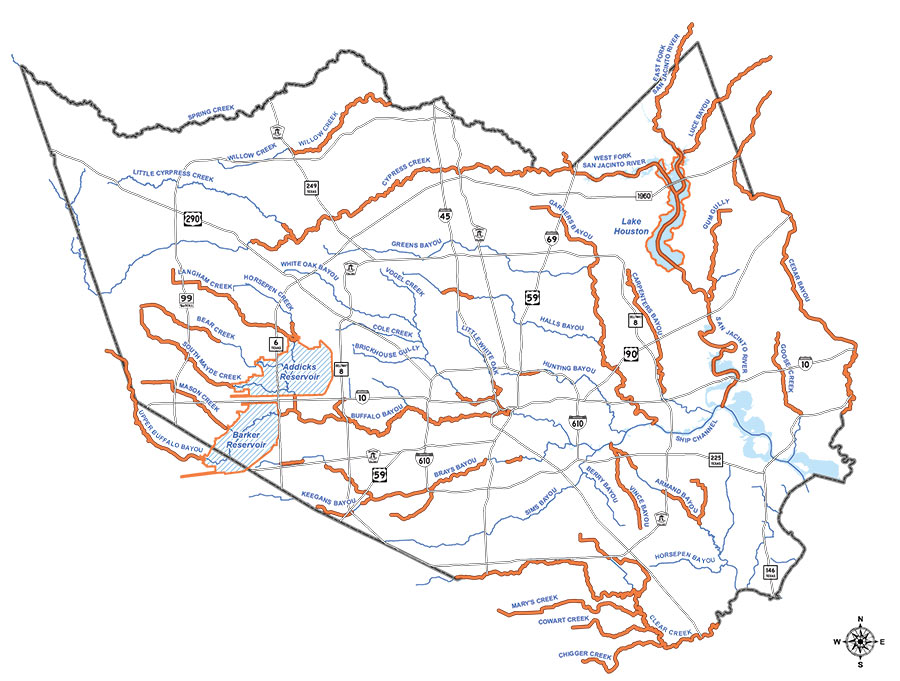
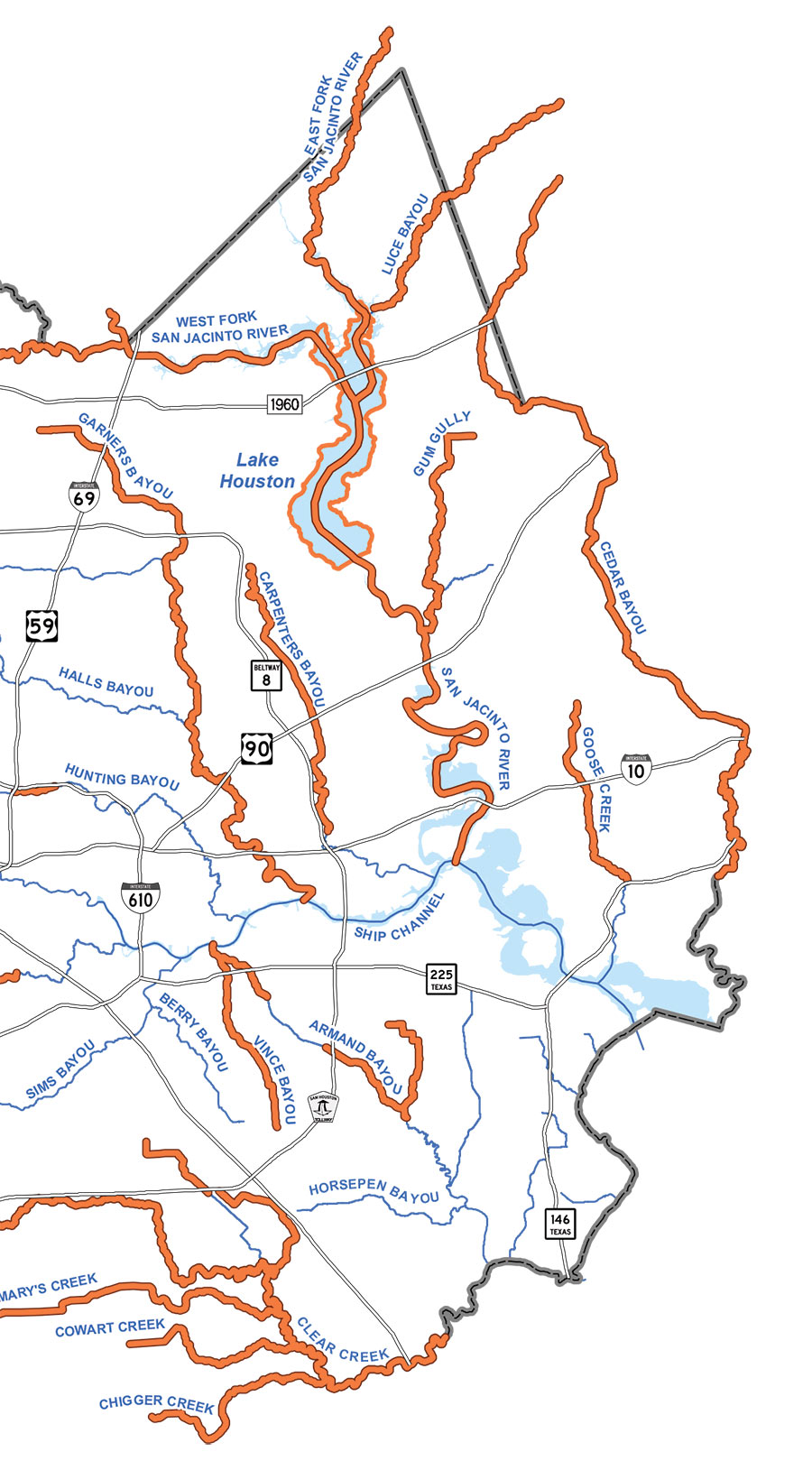
The final page of the Harris County Flood Control District’s final report on Hurricane Harvey includes the map above, with orange indicating where bayous, rivers, creeks, and gullies set new high water marks between August 25 and 29. Aside from Sims Bayou and a handful of smaller waterways, every other liquid landmark in the county outdid itself along some portion during the storm. Several — such as Cypress Creek and Carpenters Bayou (shown in detail above) — set new flood records along their entire lengths.
Less distinguished are White Oak and Little White Oak bayous, which broke records along only tiny stretches near Buffalo Bayou:
THE MIND-BOGGLING UNDERGROUND MULTI-BAYOU TUNNEL DRAINAGE SYSTEM NOW PROPOSED FOR HARRIS COUNTY 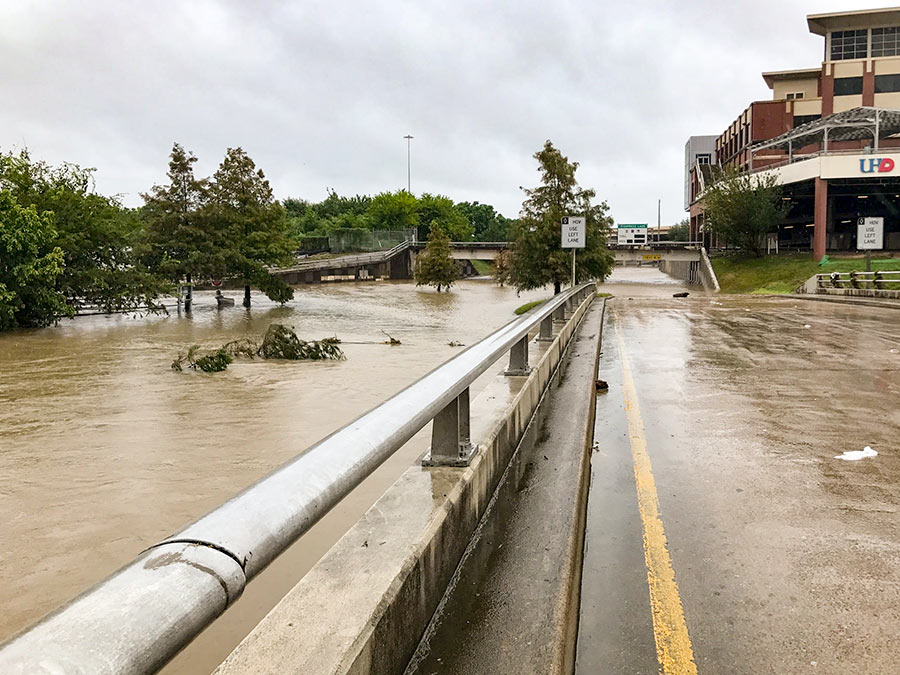 The Harris County Flood Control District is considering digging the nation’s largest network of high-volume tunnels 100 to 200 ft. underground to drain stormwater from several waterways, including — write the Chronicle‘s Mike Morris and Mihir Zaveri — Buffalo Bayou, White Oak Bayou, Hunting Bayou, Greens Bayou, Halls Bayou, Clear Creek, and Cypress Creek. “The goal under the plan,” they report, “would be for those waterways to be able to keep a 100-year storm event within their banks.” Flood czar Steve Costello argues that despite the project’s enormity, the tunnels might actually be the cheapest way to bring the all the county’s major waterways up to 100-year capacity. Even if such a one-shot solution does cost less than a series of smaller mitigation efforts, the pricetag for the tunnels would still be in the billions, or “perhaps $100 million per mile,” Costello says. On Tuesday, the Commissioners Court is set to vote on whether to pursue a contract with Fugro USA Land — a global engineering firm — for a feasibility study of the proposed project that would cost around $400,000. [Houston Chronicle ($)] Photo of Harvey flooding near UHD: Kelsie H. Dos Santos
The Harris County Flood Control District is considering digging the nation’s largest network of high-volume tunnels 100 to 200 ft. underground to drain stormwater from several waterways, including — write the Chronicle‘s Mike Morris and Mihir Zaveri — Buffalo Bayou, White Oak Bayou, Hunting Bayou, Greens Bayou, Halls Bayou, Clear Creek, and Cypress Creek. “The goal under the plan,” they report, “would be for those waterways to be able to keep a 100-year storm event within their banks.” Flood czar Steve Costello argues that despite the project’s enormity, the tunnels might actually be the cheapest way to bring the all the county’s major waterways up to 100-year capacity. Even if such a one-shot solution does cost less than a series of smaller mitigation efforts, the pricetag for the tunnels would still be in the billions, or “perhaps $100 million per mile,” Costello says. On Tuesday, the Commissioners Court is set to vote on whether to pursue a contract with Fugro USA Land — a global engineering firm — for a feasibility study of the proposed project that would cost around $400,000. [Houston Chronicle ($)] Photo of Harvey flooding near UHD: Kelsie H. Dos Santos
FUNDING FOR DOWNTOWN HOUSTON’S NEW ISLAND 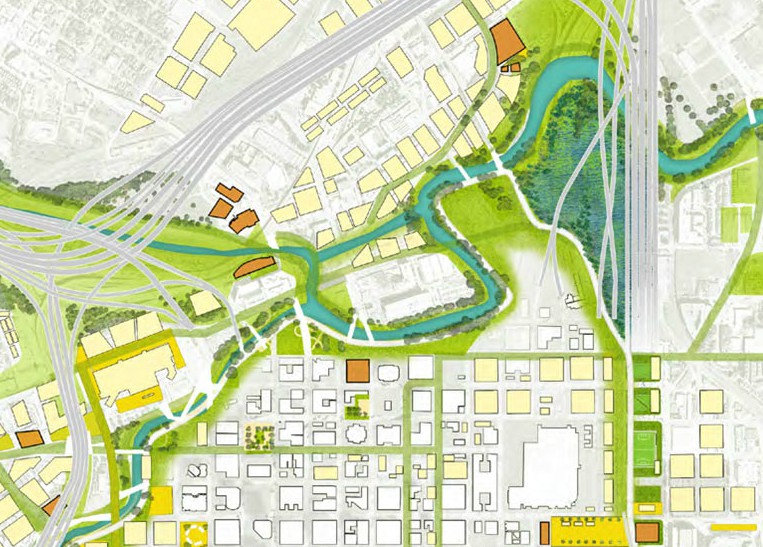 Houston’s flood czar Steve Costello tells the Chronicle’s Mike Morris that the city plans to apply for FEMA resiliency grants in order to build the North Canal Bypass — the long-whispered diversion channel that would relink White Oak and Buffalo bayous between Main and Elysian streets. The waterway concept bubbled up last year in Plan Downtown where its course formed an island northwest of Allen’s Landing indicated in the imagined map above. By bypassing the bayou’s oxbow, the channel is expected not only to reduce flooding downtown — it could also “help lower the water level in White Oak Bayou all the way to the 610 Loop and in Buffalo Bayou as far west as Gessner,” according to a county study. The result: “A little more than half of the 854 structures in the 100-year floodplain along White Oak and an adjacent tributary, Turkey Gully, would be removed from the floodplain.” [Houston Chronicle; previously on Swamplot] Map: Plan Downtown
Houston’s flood czar Steve Costello tells the Chronicle’s Mike Morris that the city plans to apply for FEMA resiliency grants in order to build the North Canal Bypass — the long-whispered diversion channel that would relink White Oak and Buffalo bayous between Main and Elysian streets. The waterway concept bubbled up last year in Plan Downtown where its course formed an island northwest of Allen’s Landing indicated in the imagined map above. By bypassing the bayou’s oxbow, the channel is expected not only to reduce flooding downtown — it could also “help lower the water level in White Oak Bayou all the way to the 610 Loop and in Buffalo Bayou as far west as Gessner,” according to a county study. The result: “A little more than half of the 854 structures in the 100-year floodplain along White Oak and an adjacent tributary, Turkey Gully, would be removed from the floodplain.” [Houston Chronicle; previously on Swamplot] Map: Plan Downtown
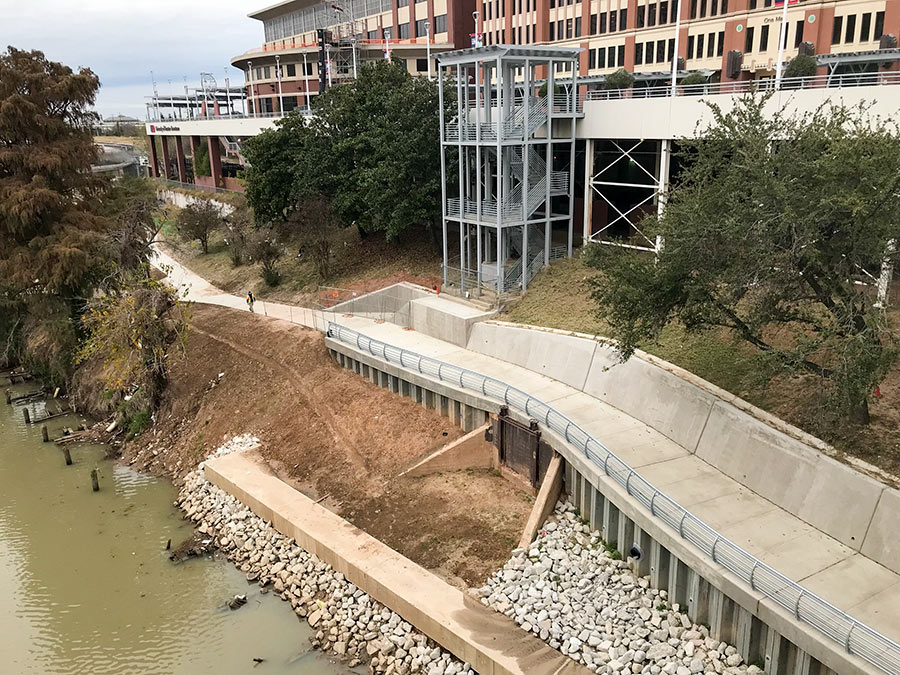
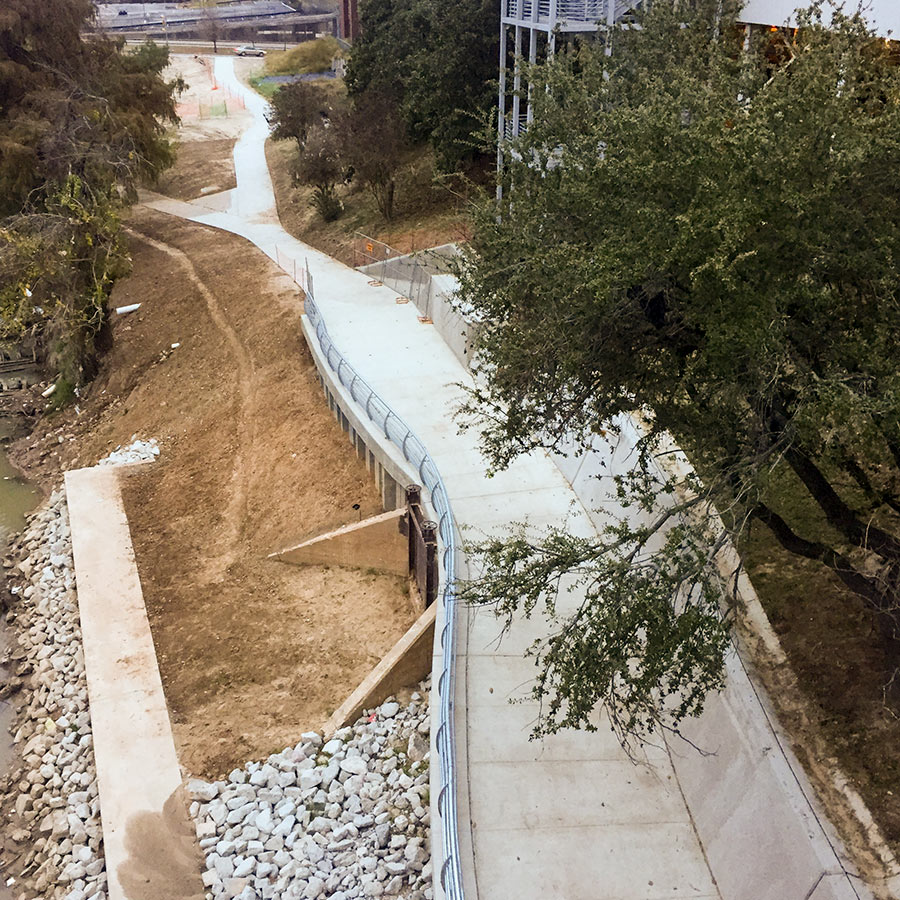
With the completion of the once-missing link shown above, the paths lining Buffalo Bayou are now fully connected to the Heights Hike and Bike Trail. Making use of the new route, you can now ride all the way from Shepherd to Heights Mercantile — provided rising floodwaters have not blocked the path. The photo at top, snapped from the southern section of the Main St. bridge, shows a new railing along the path in place of the temporary fencing that lined the edge last year. Travis and Milam streets are visible in the distance in the second photo. The elevated building to the right of the path is part of UHD’s campus.
The purple curve on the map below marks the location of the new connection, while the gray line running northwest indicates the Heights Hike and Bike Trail:
COMMENT OF THE DAY RUNNER-UP: WHY YOU SHOULD TRY BOATING ON THE BAYOU 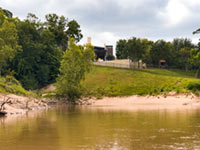 “. . . Buffalo Bayou looks really nice from a kayak or canoe, and you can see the houses from the water. I’ve encountered all sorts of wildlife including many different bird species, turtles, and an alligator. There are maps online locating the put-in / take-out spots, if you’re so inclined. Pro tip: if you’re paddling by yourself and wish to take out at the same spot you put in, paddle upstream first, and save the easier downstream half for when you’re tired and just want to go home.” [GoogleMaster, commenting on Comment of the Day: The Real Reason Why Buffalo Bayou Smells and Looks the Way It Does]
“. . . Buffalo Bayou looks really nice from a kayak or canoe, and you can see the houses from the water. I’ve encountered all sorts of wildlife including many different bird species, turtles, and an alligator. There are maps online locating the put-in / take-out spots, if you’re so inclined. Pro tip: if you’re paddling by yourself and wish to take out at the same spot you put in, paddle upstream first, and save the easier downstream half for when you’re tired and just want to go home.” [GoogleMaster, commenting on Comment of the Day: The Real Reason Why Buffalo Bayou Smells and Looks the Way It Does]
COMMENT OF THE DAY: THE REAL REASON WHY BUFFALO BAYOU SMELLS AND LOOKS THE WAY IT DOES  “If Buffalo Bayou stunk so much, then no one would have built a bunch of expensive homes all along it (west of downtown). Most of the Houston area’s waste water effluent flows into the Bayou east of downtown anyways. The Clinton/69th plant (the largest in the city) is just east of downtown, and the Sims and Braes plants don’t enter until well past downtown. With that said, I don’t think the treatment plants are the big contributors to the overall unpleasantness of the Buffalo Bayou water (flood events not withstanding). Most of the effluent (when the plants are properly operating) is nearly clear and usually only has an ‘earthy’ odor to it if any at all. I think the big issue with the bayou’s water quality is the regular runoff and trash that flows into it and eventually lines the shores of it all along downtown.” [nmj, commenting on The North Canal, a New Downtown Island, and Other Secret Plans for Downtown Houston’s Future] Photo: Swamplot inbox
“If Buffalo Bayou stunk so much, then no one would have built a bunch of expensive homes all along it (west of downtown). Most of the Houston area’s waste water effluent flows into the Bayou east of downtown anyways. The Clinton/69th plant (the largest in the city) is just east of downtown, and the Sims and Braes plants don’t enter until well past downtown. With that said, I don’t think the treatment plants are the big contributors to the overall unpleasantness of the Buffalo Bayou water (flood events not withstanding). Most of the effluent (when the plants are properly operating) is nearly clear and usually only has an ‘earthy’ odor to it if any at all. I think the big issue with the bayou’s water quality is the regular runoff and trash that flows into it and eventually lines the shores of it all along downtown.” [nmj, commenting on The North Canal, a New Downtown Island, and Other Secret Plans for Downtown Houston’s Future] Photo: Swamplot inbox
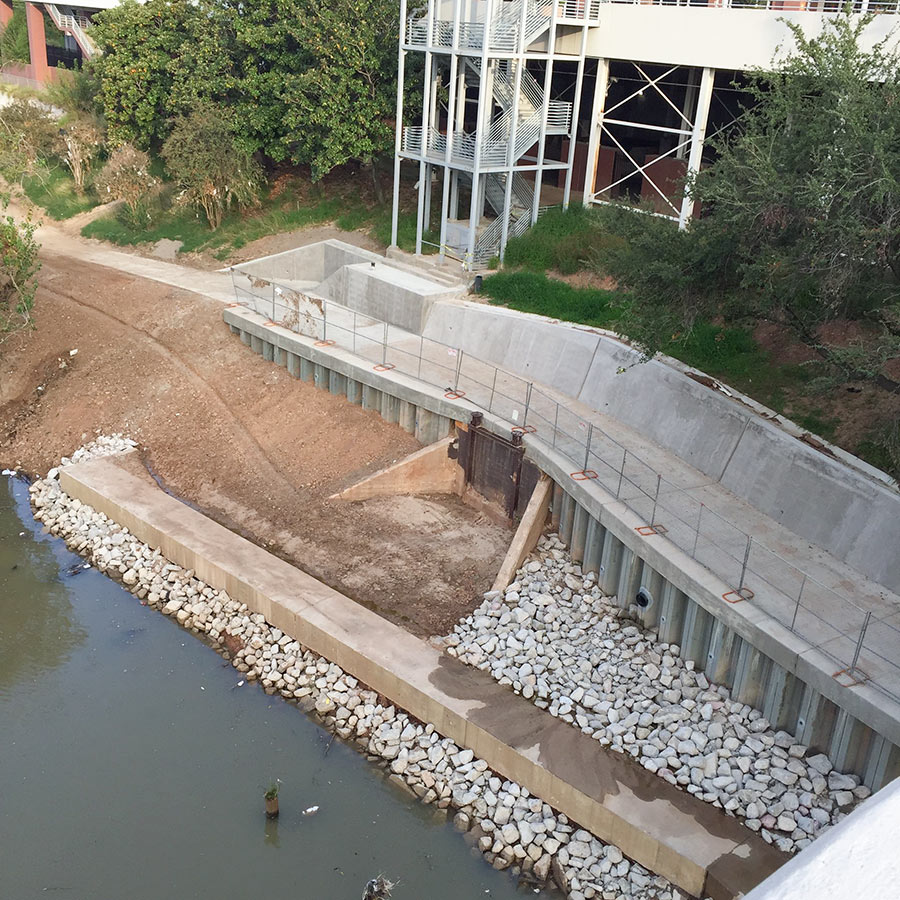
Construction is almost complete on a missing link between the bike paths lining Buffalo Bayou Park and the Heights Hike and Bike Trail, according to passer-by Christopher Andrews — who snapped the above photo from the southern span of the Main St. bridge, looking towards the back of the UH–Downtown campus. The purple curve just north of Allen’s Landing marked on the map below is the segment of the bayou trail that’s in the works. You can see where that portion will intersect the Heights trail, marked below in gray, after it crosses White Oak Bayou’s southerly meander to the east of UHD:
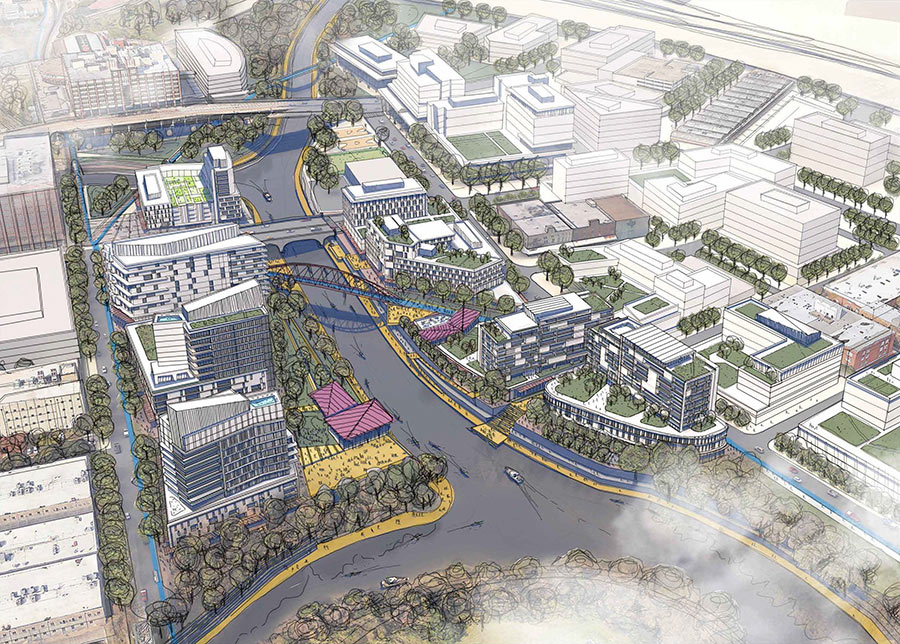
More new features are imagined for the center of Houston than just the new Green Loop highlighted in the just-released Plan Downtown proposal. There’s also a mysterious new Downtown island. Where did it come from?
It’s the result of digging the long-whispered North Canal Channel Bypass, a re-linking of White Oak and Buffalo Bayous north of Downtown. Existing bends and narrow banks along the 2 bayous just east of Main St. restrict the flow of stormwater during flooding events. According to reports, engineering studies have estimated that cutting a straighter diversion channel to bypass the oxbow could reduce flooding Downtown by 3.5 ft.
But digging a new canal while maintaining the existing path of the bayou would create an island out of the area just north of Commerce St. An imagined map of the area in Plan Downtown’s report (rotated so North is aimed down and to the right) shows what car and pedestrian bridges might link it to the mainland:
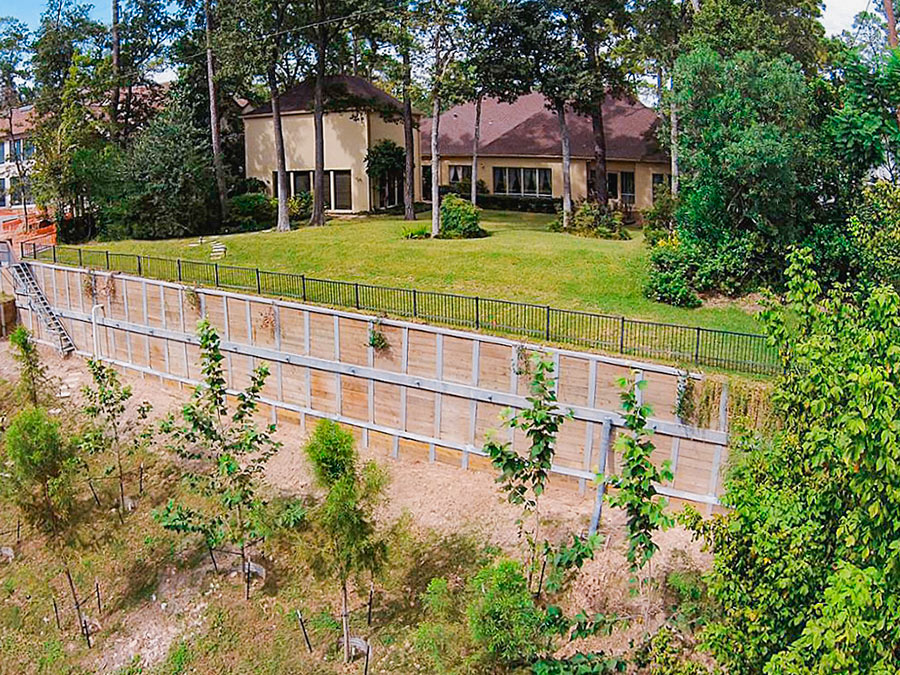
- 10915 Kirwick Dr. [HAR]
EPA: YEAH, BETTER CLEAN OUT THE DIOXIN PITS FROM THE SAN JACINTO RIVER NOW THAT THEY’VE LEAKED A bit later than had been urged by those alarmed by the longterm presence of pits full of toxic waste sealed only with a tarp on top hanging out in the San Jacinto River, the EPA has now approved a plan to remove most of the dioxin stored within them. “As exemplified today, EPA is prioritizing Superfund clean-up by making decisions in a decisive, timely manner,” reads a statement from administrator Scott Pruitt released this afternoon. “The San Jacinto Waste Pits site was added to the National Priority List nearly a decade ago.” What’s the rush? As predicted by EPA studies and many a casual observer, the pits appeared to have leaked extensively after Hurricane Harvey flooding. Under the new $115 million plan, cofferdams will be installed around the pits and almost 212,000 cubic yards of dioxin-contaminated material will be excavated — leaving just enough behind that the agency can, it says, ensure controls that will “prevent access, eliminate off-site migration, and monitor the natural recovery into the future.” [EPA; more info; Houston Chronicle; previously on Swamplot] Video of waste pits after Harvey flooding: Greg Moss

